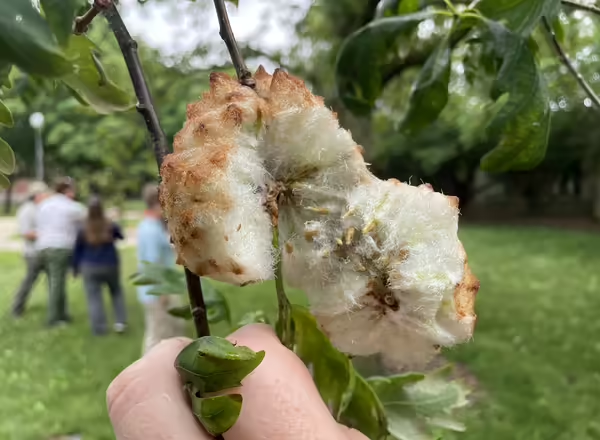
If you spend enough time looking at and working with plants, you'll inevitably come across galls. Galls are abnormal growths and can be caused by a variety of different organisms, including insects (like aphids, flies, wasps) and mites, and occasionally nematodes, fungi, and bacteria. Galls can be on leaves, twigs, roots, or flowers and can take on various appearances. One of the more attractive galls you may encounter is wool sower galls.
What are Wool Sower Galls?
Wool sower galls are created by a wasp, Callirhytis seminator. When they first develop, they are fuzzy, white to whitish-pink, round galls that resemble cotton balls. The galls are filled with fibers and small seed-like capsules, which is why they are also known as oak seed galls. Each of these 'seeds' contains a single wasp larva.
As the galls age, they will turn tan to light brown. The surface of the gall will harden and develop slightly raised points that are darker in color. The adult wasps will tunnel through the galls and emerge, leaving small holes on the surface, usually in June and July.



The Life of the Wool Sower Gall Wasp
Wool sower galls are found primarily on white oak trees (Quercus alba) but may also be found on chestnut (Q. montana), swamp chestnut (Q. michauxii ), and swamp white oaks (Q. bicolor). In the early spring, females will lay eggs in the leaf buds of an oak tree. When the egg is laid, the female releases fluids that begin the gall-forming process. When the egg hatches, the larvae will also secrete chemicals, leading to further development of the gall.
Like many other wasps in the Family Cynipidae, wool sower gall wasps will produce two different types of galls. The wasps that emerge from the wool sower galls will lay eggs in the stems, which will cause indistinct stem galls. In the spring, the wasps that emerge from the stem galls will lay eggs in leaf buds, forming the more noticeable wool sower galls.
The galls will provide food and shelter for the larvae. They will also protect them from potential predators. But they aren't 100% effective; some species of parasitoid wasps will lay their eggs inside the galls. The parasitoid wasp larvae will then feed on the larvae of the wool sower gall wasps. This can help keep populations in check and likely contributes to why we often see populations of wool sower gall wasps fluctuate from year to year.
What Should I do about Wool Sower Galls?
Like most other galls, wool sower galls don't cause any significant damage to the trees that would warrant management. The adult wasps also don't pose a threat to humans or pets (they're around 1/8 inch long and are incapable of stinging us). Even if we wanted to control them, the insects are well protected once the galls have formed, and pesticides are unlikely to reach them. While the galls can be removed if they are considered unsightly, they also make for great conversation starters.
Good Growing Fact of the Week: In a 2023 study, scientists found that gall-forming wasps have a large venom apparatus (venom gland, reservoir, duct, etc.), which suggests venom plays an important role in inducing galls.
References and for more information
"Gallformers Contributors." “Callirhytis seminator (sexgen)” Notes on ID and Taxonomy, https://gallformers.org/gall/852, www.gallformers.org. Accessed 13 June 2025.
Guiguet, Antoine, John F Tooker, Andrew R Deans, István Mikó, Gang Ning, Szabina Schwéger, and Heather M Hines. 2023. "Comparative Anatomy of Venom Glands Suggests a Role of Maternal Secretions in Gall Induction by Cynipid Wasps (Hymenoptera: Cynipidae)." Insect Systematics and Diversity 7 (5). https://doi.org/10.1093/isd/ixad022.
Winterringer, Glen Spelman. 1961. Some Plant Galls of Illinois. Vol. 12. Springfield, Ill: Dept. of Registration and Education. https://www.biodiversitylibrary.org/page/16658381
Want to get notified when new Good Growing posts are available? SIGN ME UP!
Give us feedback! How helpful was this information (click one): Very helpful | Somewhat helpful | Not very helpful
MEET THE AUTHOR
Ken Johnson is a Horticulture Educator with University of Illinois Extension, serving Calhoun, Cass, Greene, Morgan, and Scott counties since 2013. Ken provides horticulture programming with an emphasis on fruit and vegetable production, pest management, and beneficial insects. Through his programming, he aims to increase backyard food production and foster a greater appreciation of insects.